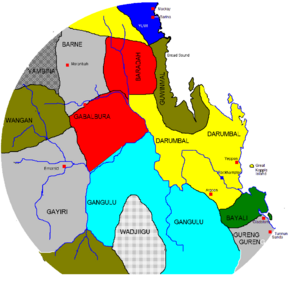Bidjara language facts for kids
Quick facts for kids Bidyara |
|
|---|---|
| Southern Maric | |
| Native to | Australia |
| Region | Queensland, between Tambo and Augathella, Warrego and Langlo rivers |
| Ethnicity | Bidjara, Kongabula, Maranganji, Gunya, Wadja, Gayiri, Wadjalang, Wadjabangai, Iningai, Mandandanji, Gunggari, Koamu (Kooma), ?Ganulu, ?Nguri, ?Yagalingu(pronounced wadja-lingu/wod-ja-ling-goo) |
| Extinct | by 1987e18 Some people might know a few words (2008) |
| Language family |
Pama–Nyungan
|
| Dialects |
Bidjara (& Gungabula)
Marrganj (Margany/Mardigan) & Gunja (Gunya)
Wadjingu (Wadjigu = Wadja)
Gayiri (Kairi)
Wadjalang (Dharawala)
Wadjabangayi
Yiningayi
Yanjdjibara
Kogai (Mandandanyi/Mandandanjdji, Gunggari/Kunggari, Guwamu/Kooma)
Ganulu?
Nguri?
Yagalingu?
|
| AIATSIS | E37 Bidjara, D38, D42 |
Bidjara, also known as Bidyara or Pitjara, is an Aboriginal language from Australia. In 1980, only about twenty older people spoke it. They lived in Queensland, between the towns of Tambo and Augathella, near the Warrego and Langlo Rivers.
Bidjara has many different ways of speaking, called dialects. Some of these include Gayiri and Gunggari. Today, people are working hard to bring some of these dialects back to life. They are even teaching them in local schools in the area.
Contents
Bidjara Language Dialects

The Bidjara language had many different dialects. The main Bidjara dialect was the last one to stop being spoken.
One of these dialects was Gunya (also called Kunja). It was spoken over a very large area. This area stretched from the Warrego River near Cunnamulla north to Augathella. It also went west towards Cooladdi and east towards Morven. The last known person to speak Gunya was Fred McKellar. Another dialect, Yagalingu, is not well known. It might have been a dialect of Bidjara.
Natalie Kwok wrote a report about the Gunggari dialect. She explained that language was a big part of how Gunggari and Bidjara people identified themselves. Even though experts say the languages were very similar, the people who spoke them felt the differences were important.
Lynette Nixon shared a story about her father. He would talk with the Gadd brothers, and they could understand each other. But each person spoke their own language. Ann-Eckermann also told a story:
- Bert Mailman (who spoke Bidjara) and Aunty Mini Dodd and Aunty Annie Currie (who spoke Gunggari) would call out to each other in their languages.
- Bert couldn't really understand what the ladies were saying.
- He got frustrated because the women were making fun of him!
The Wadjigu language region is another important area. It includes places like the Aboriginal Shire of Woorabinda and Central Highlands Region. This area also covers the Blackdown Tablelands, the Comet River, and the Expedition Range. Towns like Woorabinda, Springsure, and Rolleston are also in this region.
Bringing the Language Back to Life
Reviving Bidjara
Australian Aboriginal artist Christian Bumbarra Thompson uses his Bidjara language in his video art. He wants to share his language with more people. His video Gamu Mambu means "Blood Song." In it, a Dutch opera singer sings in Bidjara. This artwork was shown at a big art event called the 17th Sydney Biennale.
During NAIDOC Week in 2019, Owen Stanley, a Bidjara man, talked about losing his language. He felt sad that he wasn't fluent in his own language. He said his grandmother was one of the last 20 elders who spoke the language. Now, people are trying hard to bring the language back.
Reviving Gunggari
As of 2021, only three native speakers of the Gunggari language were left. One of them was Aunty Lynette Nixon, who was named Elder of the Year. A big effort to bring the language back has been happening in Queensland schools. St Patrick's School in Mitchell started teaching Gunggari around 2013. Mitchell State School also began teaching it.
Aunty Lynette and the Gunggari Native Title Corporation (NTC) are creating the first Gunggari dictionary. The Gunggari NTC also holds language workshops for adults. These workshops help people learn their ancestors' language. The first workshop outside their traditional lands was held in Toowoomba. As of November 2021, they planned to offer workshops in Brisbane, Woorabinda, and Mitchell.
See also
 In Spanish: Idioma bidyara para niños
In Spanish: Idioma bidyara para niños

